10 Facts about Siberian Pine
Siberian pine is the most important tree in Siberian taiga forests. Let’s figure out how a cedar tree differs from a pine tree, what macrostrobili are, whether a cedar tree has a nanny
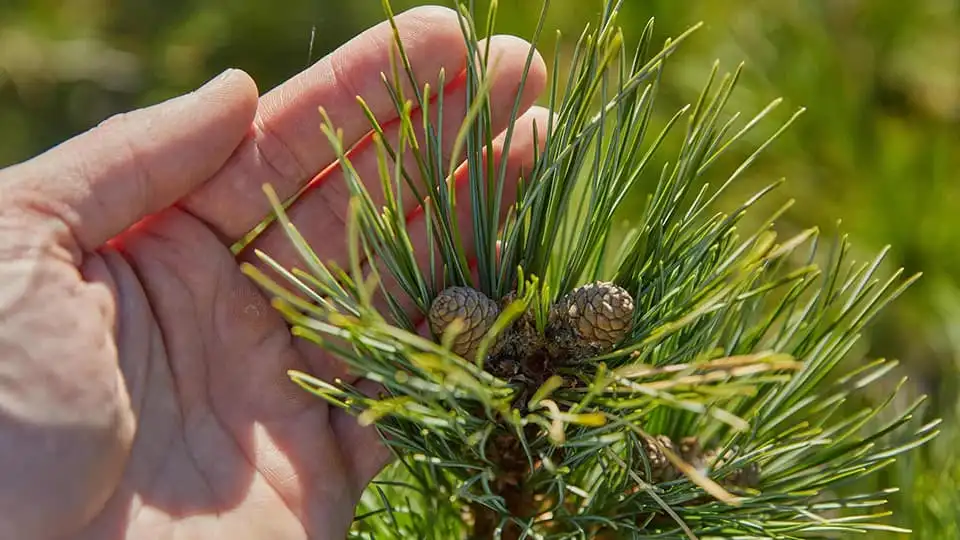
Siberian pine is the most important tree in Siberian taiga forests. Let’s figure out how a cedar tree differs from a pine tree, what macrostrobili are, whether a cedar tree has a nanny, and why people in Tomsk erected a monument to a nutcracker.
Cedar tree or pine tree?
Siberian cedar is the name of a tree that has taken root in Russia. Yet, due to scientific botanical classification, it is not a cedar at all, but a pine tree.
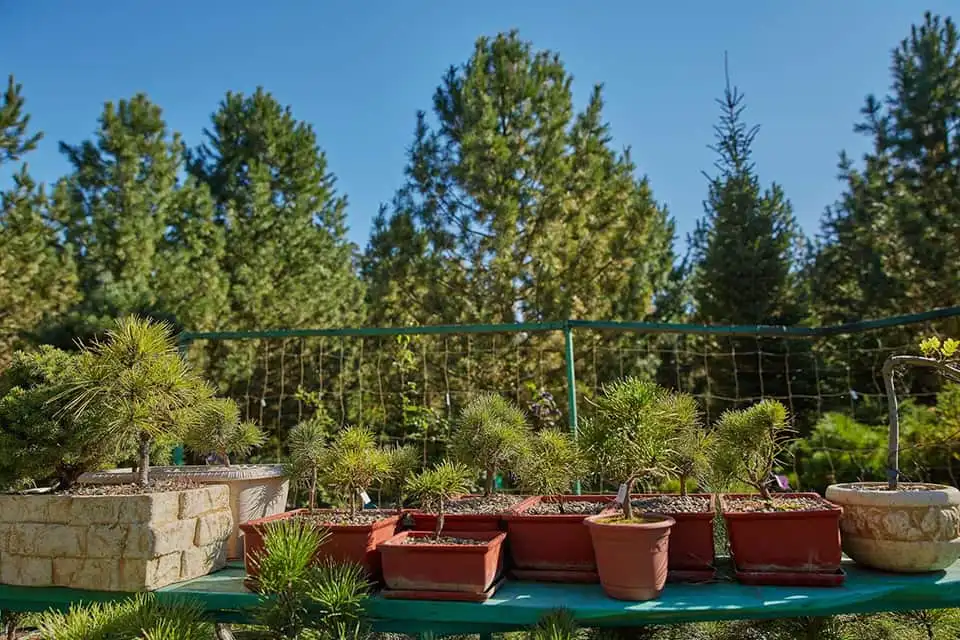
Scientific station «Kedr» is located in Kurlek, a village 25 miles from Tomsk. It is a plant nursery where about 5,000 varieties of various plants are grown, the creation of biologist Sergei Goroshkevich.
Conifers have been growing on Earth since the Paleozoic: some of their fossils are 300 million years old. One of the Conifers class families is the Pine family, or Pinaceae. These include Pinus Sibirica, a Siberian cedar pine, known to us as Siberian cedar. It, like three other species — Pinus pumila (dwarf cedar), Pinus cembra (European cedar pine), and Pinus koraiensis (Korean cedar pine) are called «cedar pines». But cedar (Cedrus) is another species of conifers, which includes four species — Lebanon, Himalayan, Atlas, and short-coniferous cedars.
Why did this «botanical» confusion come from? Sergei Goroshkevich, a biologist and head of the dendroecology laboratory at the Institute for Monitoring Climatic and Ecological Systems of Siberian Branch of Russian Academy of Sciences, explains it.
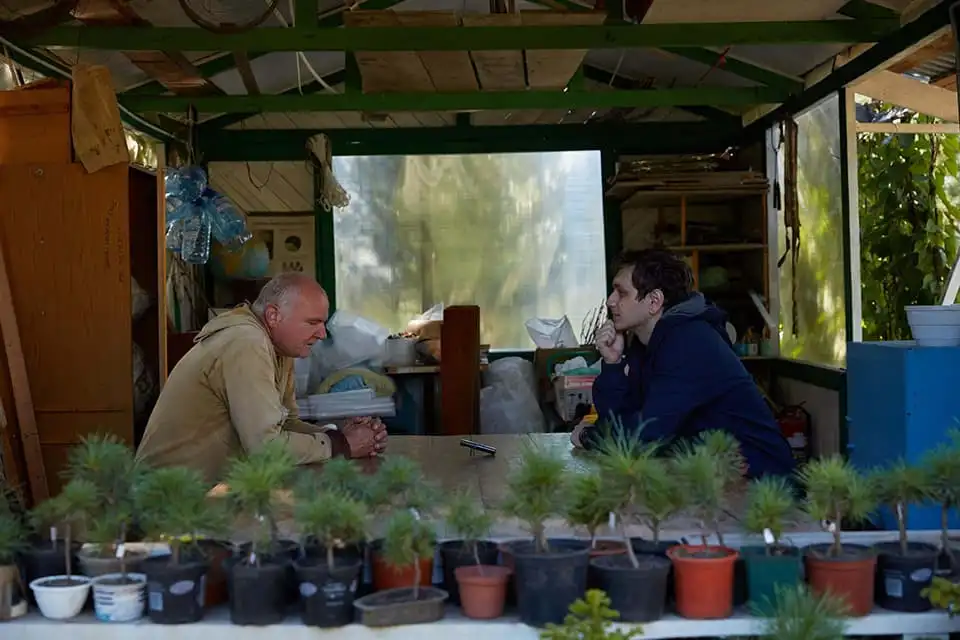
Biologist Sergei Goroshkevich has been growing pines in Tomsk, Siberia, since the 1980s.
While exploring our planet, Europeans faced the need to name more and more new plants. Russian colonization developed towards Siberia, where dendroflora, or flora of woody plants, is also not incredibly rich. Only three species of plants with «cedar» names appeared in Russian, and all three owners of such terms turned out to be close relatives. British colonization covered, in essence, the rest of the world. The result is obvious: in modern English, about 75 species have the word «cedar» in their name. The three species in question have much more reason to be called «cedars» than not only all 75 «cedars» from English terminology but even the representatives of the genus Cedrus themselves.
Actually, the alpine species Pinus cembra, very close to Pinus sibirica, was well-known to the ancient Romans. It was called «cedar (ceder)». In transforming Latin into modern Italian, this name first became «cedro» and then into «cembro». The Middle East was for the Romans about the same as Siberia was for the Russians, i.e., the object of conquest and colonization. Accordingly, the principle of naming new plant species was precisely the same: unknown plants got associated with something similar to known ones. Thus, having seen that plant in the Middle East mountains, which is now called the Lebanon cedar (Cedrus libani), the Romans called it «cedrus», which means «like a ceder», «cedar-like».
According to Siberian biologists, calling the Siberian pine a cedar, Siberia’s colonizers were right in returning the tree to its «historically priority name».
Siberian Pine is a long-lived tree
Siberian pine is a long-lived tree. And the more severe the conditions, the slower it grows and the longer it lives. A common Siberian pine in a near-village pine forest lives for at most 200 years. If Siberian pine grows in the dark, dense taiga, it grows little by little and can live for 300-350 years. And if it is somewhere in the north or a swamp, it can live up to 600 or 700 years.
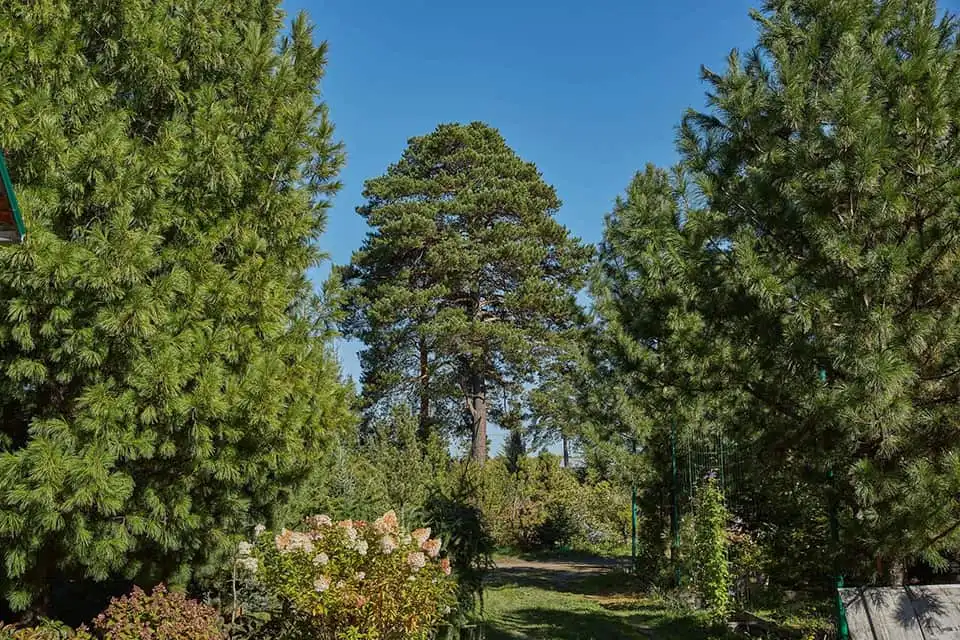
In Sergey Goroshkevich’s Siberian pine nursery, more than 1000 varieties of plants are grown, derived from only four prominent conifers of a temperate climatic zone — pine, spruce, fir, and larch.
So, in the Tomsk region, a Siberian pine was found that lived up to 670 years — its age was reliably determined. The long-liver tree grew up 12 miles from Kurlek, between the Tom and Ob rivers. There it took a fancy to a small island among the swamps. By the way, despite its venerable age, the size of Siberian pine was not very large; the tree was crooked, low, dry-topped.
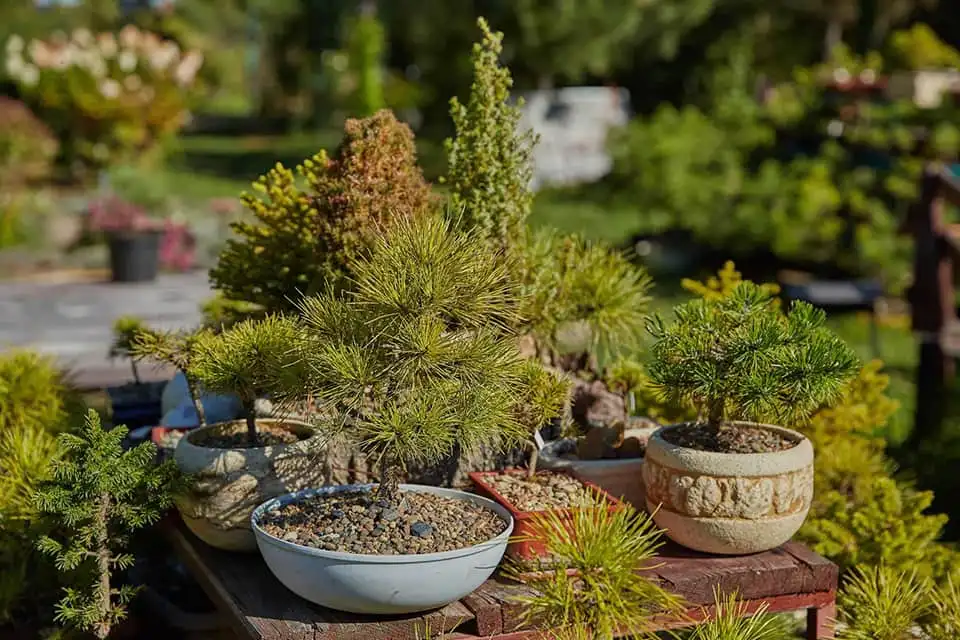
Small Siberian pines in pots — bonsai, exact copies of a real tree in miniature.
The growth of a pine depends on local conditions in which it finds itself — it grows faster on well-moisturized and fertile soil. In the first years of life, Siberian pine grows slowly, especially with a lack of light. Living under the forest canopy, by five years, the tree reaches a height of 3-6 inches, by 10 — 6-14 inches, and by 20 years — 14-30 inches. The most active time for tree growth is from 50 to 120 years.
Seasonal growth in height for Siberian pine begins in late May-early June (depending on weather and lighting) and lasts 45-50 days. Sometimes a warm August with abundant rains allows trees to grow even more — the buds laid for next year open up already in this one.
Birch is a nanny for Siberian pine
Birch is a «nanny» for Siberian trees, as the Siberians say, and they have every reason for this. The fact is that birch, known as pioneer species, is the first to populate new territories (cleared by forest fires, other disasters, or occupied by dead trees). A deciduous tree lives for about 100 years. A Siberian pine successfully settles next to it, then it gradually grows. Meanwhile, birch creates all conditions for a neighbor’s future life — it dries up the soil and enriches it with nutrients. Henceforth, after the death of the nanny, it happily lives.
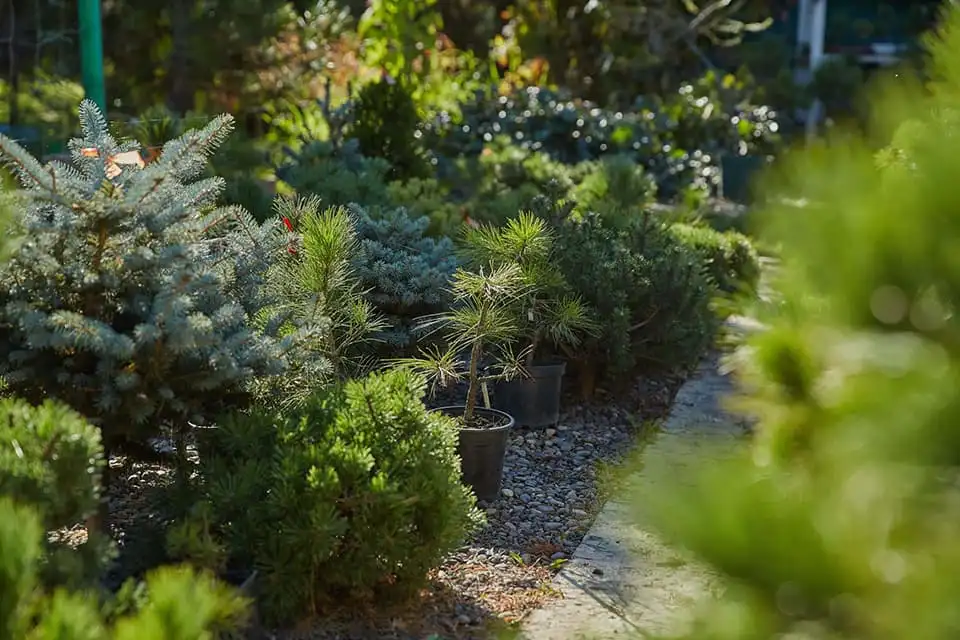
Conifers nursery in Siberia
Yet Siberian pine has a kind of competitor in the plant kingdom — this is a fir tree. It is more shade-tolerant and can displace pine. Besides pines, the Siberian dark coniferous forest has fir and spruce. At the same time, they are unequivocally competing with each other. These forests are in harmony — somewhere more shade-loving fir dominates, somewhere spruce, and somewhere more Siberian pine. The same fir loses out to Siberian pine on moist soils. On dry and poor soils, spruce is ahead of the rest.
Planting trees using Birds
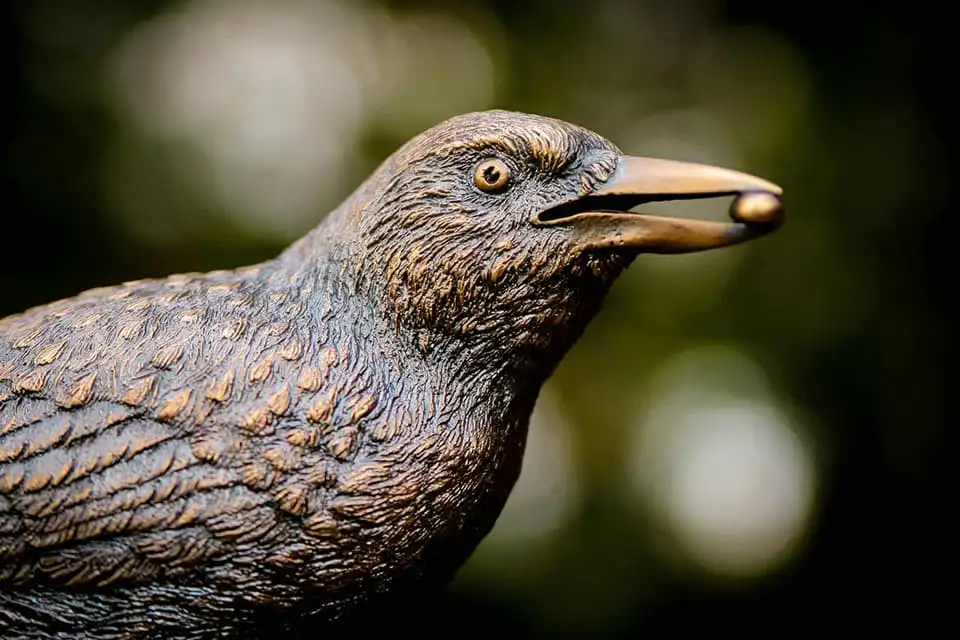
A monument to nutcracker in Tomsk
Siberian pine is a zoochoric tree: animals help to disperse the seeds. Pine forest does not regenerate on its own. It grows, swamps the soil around him, and dies. In its place, birches again come, which are «nannies» to other pines, whose seeds are brought by birds — mainly birds nutcrackers. Sixty species of birds inhabit Siberian forests. More than 20 of them eat pine seeds, but only six species contribute to the tree’s dispersal. But animals help — mostly squirrels, chipmunks, and wood mice — as they lose pine nuts during the preparation of their winter supplies.
It is a nutcracker bird; a monument to this bird was erected in Tomsk. She also collects nuts and stores them in small batches, hiding them under the moss. It says: “To the bird that gives life to the pine forests”.

The monument to a nutcracker bird was unveiled in Tomsk on September 20, 2013, in Igumensky Park (the year 2013 was declared the year of environmental protection in Russia). A 40 lbs bronze bird sits on a small stump trimmed with real petrified bark, which is about 250 million years old. Sprouts are making their way through the bark, symbolizing new life. A bronze nutcracker holds a pine nut in its mouth. The initiative to create the monument belongs to the Department of Natural Resources and Environmental Protection of the Tomsk Region. The author of the memorial is the Siberian sculptor Igor Kolomiychenko.
Under the moss, Siberian pine seeds feel very good, as it protects them from encroachment and temperature fluctuations. Moreover, the sprouted root is closer to the ground and does not have to overcome the moss layer.
Some large enterprises, municipal and regional authorities, and ordinary residents are engaged in planting Siberian pine in Russian regions. Unluckily trees planted by philanthropists do not always survive: if their cultivation conditions are not met — like, it lived in a too shady place.
Some companies do not just plant Siberian pines but provide further care for the trees. One of the active participants in the “pine movement” is Gazpromneft-Vostok, Russia’s oil and gas industry leader. The company has been taking part in environmental campaigns for several years. It has been cooperating with the Regional Committee for Environmental Protection and Nature Management, purchasing planting material for future pine forests. Employees of the enterprise, uniting with their families, travel to the pine forests in a suburb. They plant pine trees, monitor their survival rate, and protect them from harmful influences. A pine forest in Zorkaltsevo, sponsored by the company’s employees, is one of the most successful eco-projects in the Tomsk region.
In 2018, Gazpromneft-Vostok, together with the Department of Natural Resources and Environmental Protection of the Tomsk Region, held a marathon of environmental quizzes for school children. The knowledge gained from implementing this project allows children to quickly navigate ecology issues, conservation of biological diversity, and wise use of natural resources.
Siberian pine cannot be grown at home
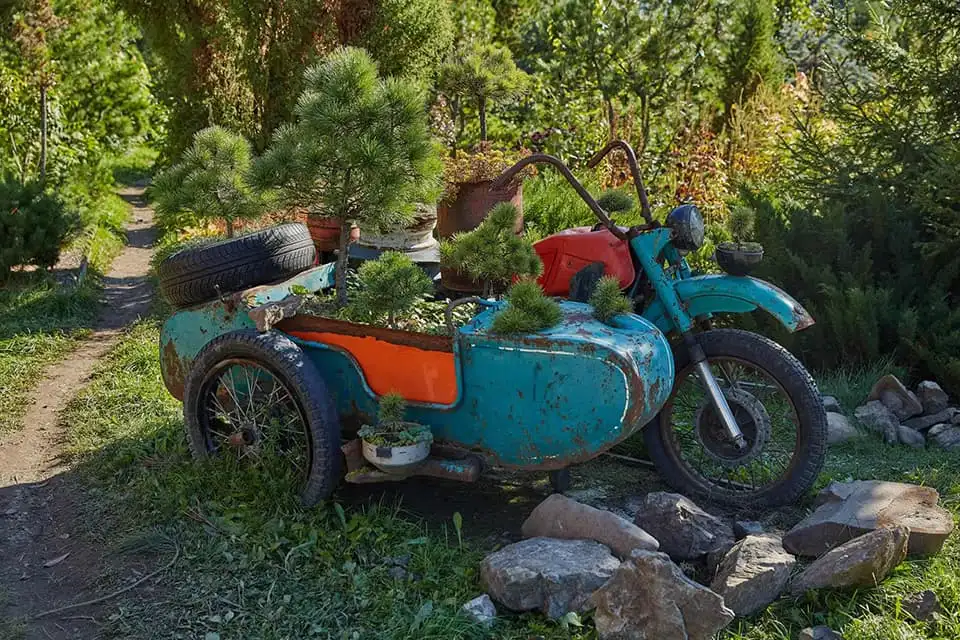
A motorcycle made of Siberian pine is one of the attractions of the local scientific station.
Siberian pine is a pure forest plantation tree; it is impossible to grow it indoors. Even if it is possible to germinate the grain, the tree will still die after a year of life, as Siberian biologists say. The same fate would befall any pine tree in the spring if it were brought the previous fall indoors.
Siberian Pine needs to live in a climate in which all its ancestors were born and lived. For the same reason, Siberian seedling does not take root in Kyiv or Minsk, where they have repeatedly tried to transport it. The Siberian tree either did not take root in Sochi, a region with a humid subtropical climate with mild winters.
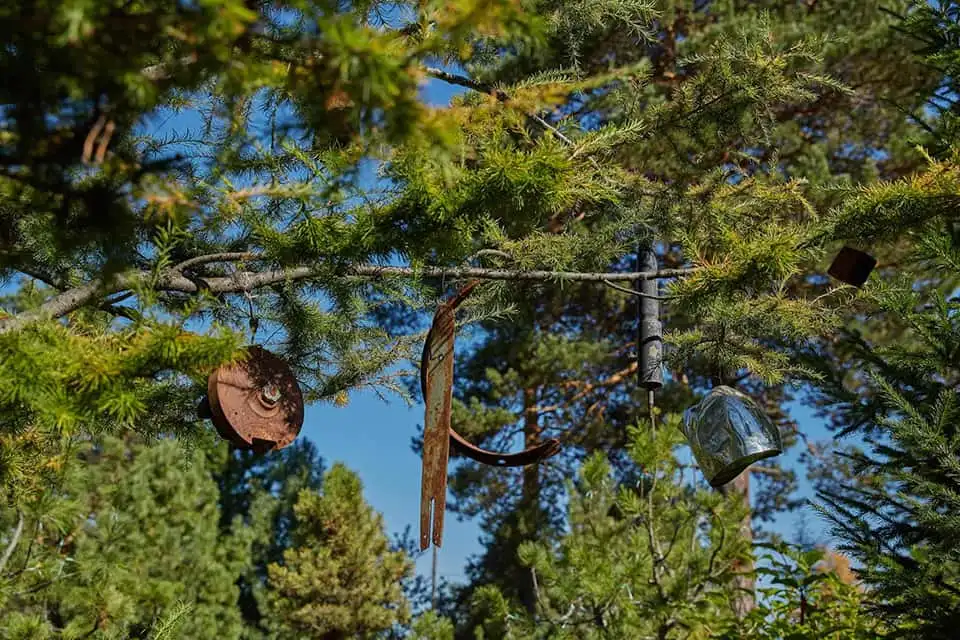
Placing loads on branches allows the Siberian tree to form an unusual crown shape.
Siberian pines «go» to school
In pine nurseries, trees are grown in several stages. For up to three years, they are grown in the sowing department. Depending on individual characteristics (if it grows slowly), a tree can sit in a kind of «kindergarten» for five years.
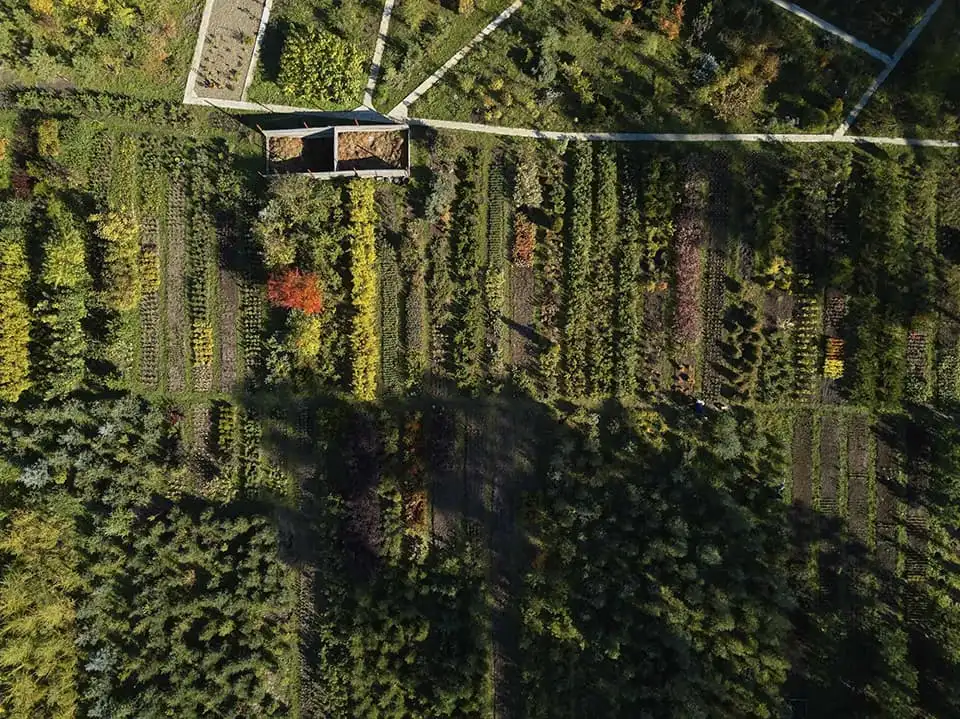
Siberian Pines
You should plant Siberian pine in a simple way — with their roots down. The quality of soil is not essential. Siberian pine in high mountains grows on a bare stone. In this regard, the tree is entirely unpretentious.
After kindergarten, the shoots are transplanted to «school» — in fact, to the same garden beds, only pine sprouts are planted farther apart. Here trees grow and are «brought up». Depending on the purpose, the pines can be planted closer or further apart. As a model, if you plant trees less often, they will grow large and spread.
In a «school», trees can spend up to 15 years. They can then go to the second «school», where they will be «brought up» for decorative purposes, or to the landing site, where they will spend their long life.
Siberian pine has a thin bark
Despite its impressive appearance, Siberian pine is susceptible to mechanical damage due to its thin bark. Any wound left on its body, notably from a punch, with the help of which cones are collected, makes the tree vulnerable to fungal infections and fires. Fire is especially dangerous in pine forests with a teenage tree or the second tier of fir wood. In them, even a small ground fire quickly turns into a top fire. This is facilitated by the essential oil-rich and therefore flammable fir needles and the low sinking of fir branches to the ground.
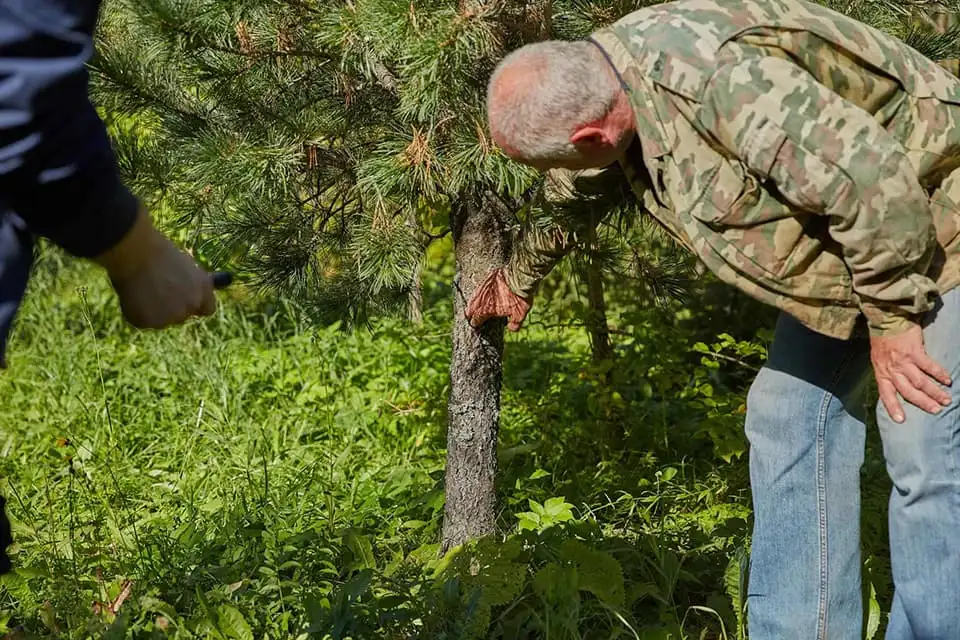
Biologist shows Siberian pine is susceptible to mechanical damage due to its thin bark.
Siberian pine has seeds, not nuts
Siberian pine nuts are actually seeds. The confusing name is apparent — these seeds are very similar to seeds of «nut» type fruit. However, like walnut kernels, peanuts, or coconut, the seeds inhabiting pine cones are not nuts from a botanical perspective.
The same tree has both female and male cones — some are macrostrobiles; others are microstrobiles. They differ in size, color, and location on the tree. So, purple females grow on the thickest branches in the upper part of the tree crown, and cherry-red males grow in the middle and lower, at the base of fresh tree shoots that have grown in the current season.
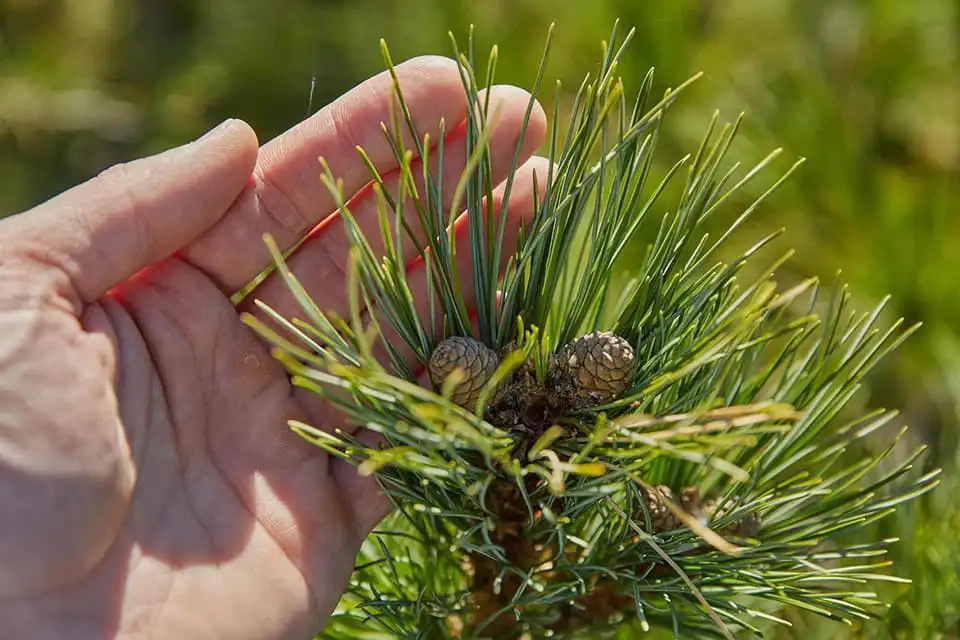
Usually, pinecones are divided into three groups by size: 1-2 inches, 2-3 inches, and over 3. The shade of cones on different trees may differ, but the same shape and color will always dominate one tree.
Siberian pine trees bloom late May-early June. Pollen spills out from male cones and gets carried by the wind — its amount reaches 290 lbs per hectare. Female cones can winter after pollination, and only the next year develop into a standard pine cone. The whole cycle of nut formation takes 26 months.

The view in Siberian pine nursery
Concurrently, Siberian pines begin to bear fruit from 25-40 years, although single cones may appear earlier. A healthy tree can produce nuts for up to 500 years. Each pine cone contains 30 to 150 seeds, each about one-quarter of an inch long and half an inch wide. One thousand seeds can weigh up to 9 oz. From one tree, you can get up to 26 lbs of nuts per season. On branches of Siberian pine, usually from 1 to 5 cones are formed, less often up to 10. In productive years, up to 140 cones can be collected from one tree. The best harvests are worth waiting for after a cold, short summer.
Siberian pine adapts to environmental conditions
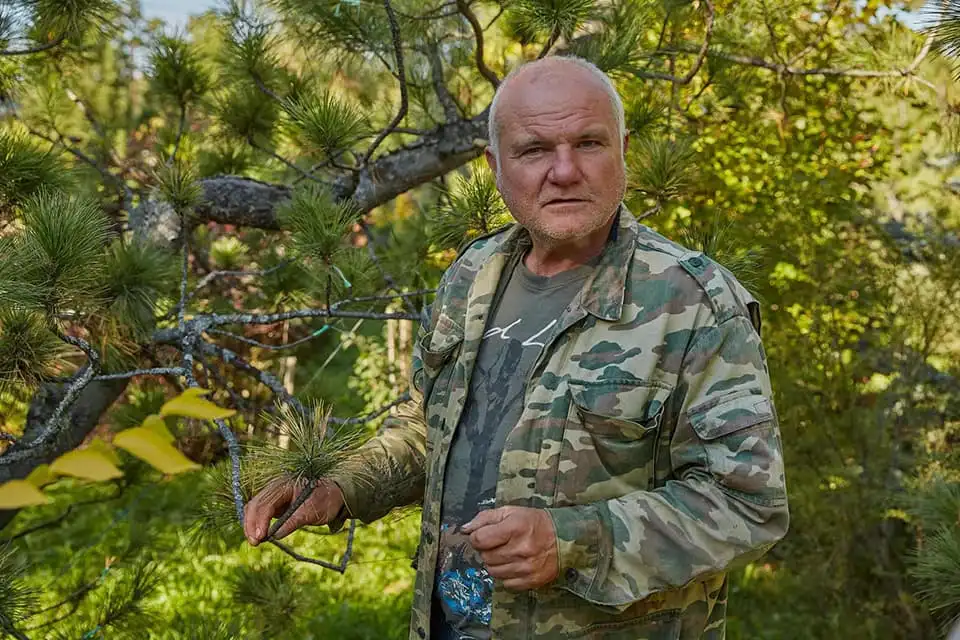
Siberian biologist Sergei Goroshkevich
Siberian pine better than other Siberian conifers adapts to the conditions of the environment in which it lives. This adaptability is especially noticeable considering air humidity and soil temperature.
For example, in humid and cold climates, the pine tree chooses heated slopes with drier soils. On the other hand, in warmer conditions, it prefers the colder and most humid habitats. In places where it is quite warm and suitable humidity, pine grows on any relief elements.

A motorcycle made of Siberian pine
If the ground in the area where pine grows thaws late, it forms a shallow root system with long roots, which give the tree additional support. Often in such cases, its roots grow together with the roots of neighboring pines. It increases the wind resistance of trees and allows them to stay on mountain slopes.
Where the soil is very moist and a significant moss cover, Siberian pine grows adventitious roots. These are the roots that extend from the stem or the leaves of plants — they can speed up the tree’s growth and make it more resilient.
Siberian pine as an indicator of climate change
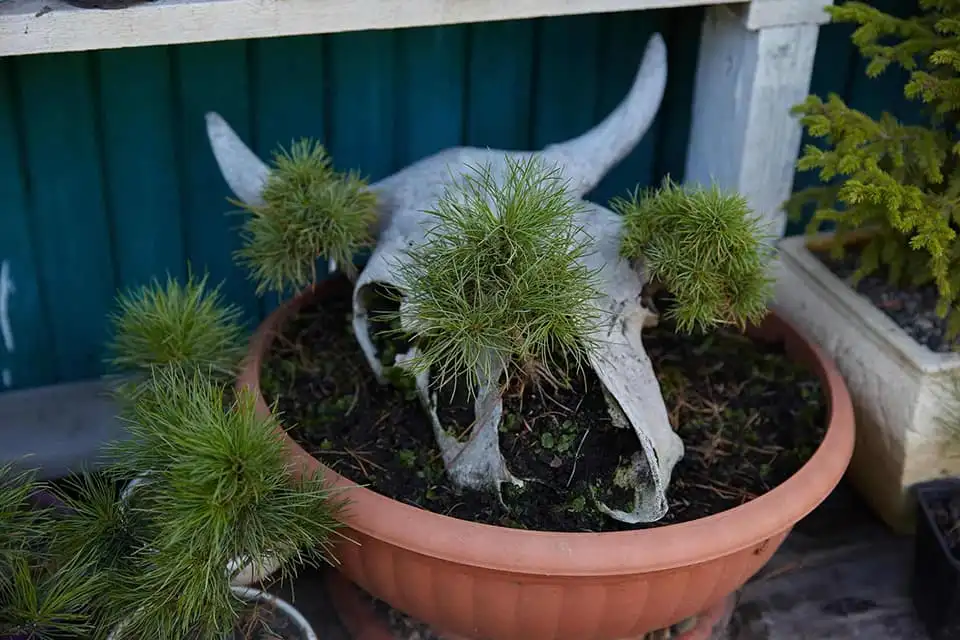
There are a variety of artifacts in the scientific hospital.
Siberian pines have a vast distribution area — about 5 million square miles. They can be found in the territory from the northeast of European Russia to southern Yakutia and from the Arctic Circle to Mongolia.
At the same time, Siberian pine is very whimsical to the climatic conditions of its residence. It must grow in the same conditions in which its ancestors and the ancestors of its ancestors lived. Therefore, if you transfer pine from the north of the Tomsk region to Tomsk city, where the air temperature is 2 degrees lower, it will be a disaster for your tree.
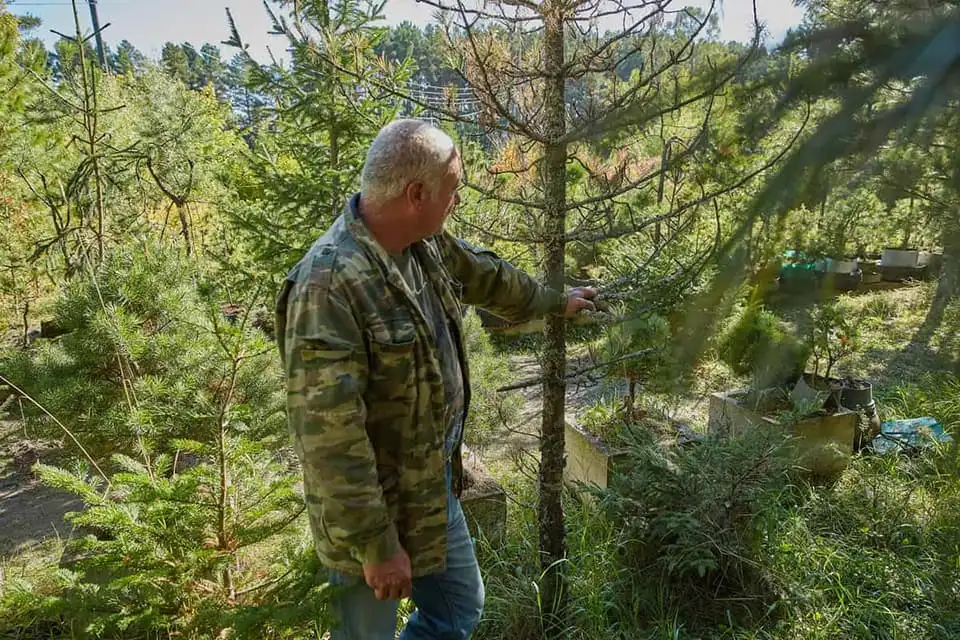
Siberian biologist in a pine nursery.
Siberian biologists explain this with an example: you can consider two Siberian pines of the same age. One has a body mass 100 times more, it is healthy and thick, and the other dies. The fact is that one pine tree historically grew in Tomsk and is now growing at home. Second pine has grown in Tomsk, from a seedling of a tree that lived in the West Sayan Pass, the border with Khakassia. Its ancestors lived at an altitude of 2100 meters above sea level climate close to the Arctic. There is no frost-free period; snow can be knee-deep in July. Siberian pines live well in such conditions, but they receive ten times less heat than in Tomsk. In the Tomsk climate, they receive the required amount of heat by June 10, and after that, for three months, they do not know what to do. According to their biological calendar, winter should begin, and in Tomsk, on the contrary, summer. And instead of living and developing, it consumes the last food reserves, getting damaged by all sorts of pests that attack a weakened woody organism. Accordingly, if rapid warming occurs on the planet, then the entire pine population can share the Sayan Siberian pine’s fate growing in Tomsk.
Thus, Siberian pines are already experiencing rapid climate changes. First of all, they affect the reproductive function of trees — the yield of pine nuts decreases. Next, if changes took place at the rate usual for the Earth, the pine tree would simply leave the Tomsk region since it is located at the southern, the warmest limit of its residence.
References
- Bekh I.A., Krivets S.L., Bisirova E.M. Kedr – zhemchuzhina Sibiri [Cedar is the pearl of Siberia]. Tomsk, Pechatnaya manufaktura Publ., 2009.
- Materials of the websites of the scientific station “Kedr” and IMCES SB RAS: imces.ru, kedr.forest.ru
- All photos are by Sergey Stepin.